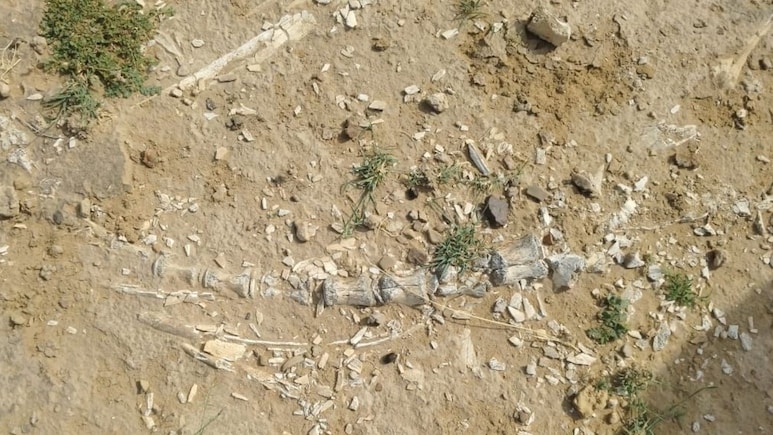
- Fossils discovered near Jaisalmer were identified as the first well-preserved phytosaur remains in India
- The fossil is about two metres long and dates back to the Jurassic period
- Phytosaur remains suggest rich aquatic life in the Thar Desert 180 million years ago
Fossil remains discovered last week in a village near Rajasthan's Jaisalmer have now been identified as belonging to a phytosaur, making it the first well-preserved specimen of the prehistoric era reptile found in India.
The fossil, about two metres long, was found by locals while digging near the lake in Megha village, approximately 45 kilometers from Jaisalmer.
Initially reported to the district administration and archaeology department by locals, the remains were confirmed by a team of geologists as a phytosaur's fossil dating back to the Jurassic age. The remains were also found alongside what appeared to be a fossilised egg, which experts believe could have belonged to the reptile.
"The phytosaur looks like a crocodile, and the fossil is 200 million years old," Professor VS Parihar, senior paleontologist and dean of Earth Science System at Jai Narain Vyas University, Jodhpur, told NDTV.
"The fossil indicates a medium-sized phytosaur that probably lived near a river here millions of years ago and ate fish to survive. Phytosaurs are believed to be 229 million years old and could also be from the early Jurassic age," he added.
A type of phytosaur fossil was found on the Bihar-Madhya Pradesh border in 2023, but scientists said this is the first definitive, well-preserved find in India.
Experts said that the discovery of phytosaur remains from the Jurassic period, which was 180 million years ago, points to a rich aquatic life that existed in the Thar Desert.
"Around 180 million years ago, it was an area where the dinosaurs thrived in the Jurassic age, and Jaisalmer is part of what geologists term the Lathi Formation," Geologist Dr Narayan Das Inakhiya, who has been leading fossil studies in Jaisalmer, told NDTV.
"Situated in the western corner of Jaisalmer, the Lathi Formation is about 100 kilometres long and 40 kilometres wide. The rock formation here indicates freshwater and marine life and an aquatic environment. That's why it is no surprise that the recent fossil find has been identified as a phytosaur, as in this area, there was probably a river on one side and a sea on the other," Dr Inakhiya said.
Speaking about the possibility of Jaisalmer being developed as a site for geo-tourism, Dr Inakhiya said, "There are root fossils, marine fossils, and of course the dinosaur finds which should be conserved and preserved for scientific study."
"The underground water channels of the mythic Saraswati, close to the Tanot area on the border with Pakistan, are also of huge interest. These are underground channels, but geologically speaking, they are very recent, about 5,000 to 6,000 years older than the Vedic period," he added.
Phytosaurs looked almost exactly like living crocodiles. They had short legs, wide, heavy bodies with rows of armoured scales, long tails, and long, toothy snouts. According to a study, the only obvious difference between crocodiles and phytosaurs is that crocodiles have their nostrils at the ends of their snouts, and phytosaurs have them on a raised hump in front of their eyes. Despite the strong similarities between phytosaurs and crocodiles, the two groups are not closely related.
The discovery near the ancient lake in Megha village is possibly the fifth dinosaur-related discovery in the region.
Villagers had gathered at the site in large numbers after the discovery, sharing videos and photos of the remains on social media.
Paleontological remains have been discovered in Jaisalmer over the years, including bone fossils in Thiyat, a dinosaur footprint, and a well-preserved dinosaur egg found in 2023.
Track Latest News Live on NDTV.com and get news updates from India and around the world

